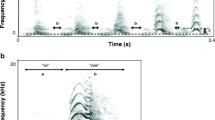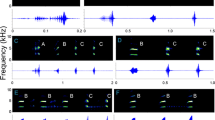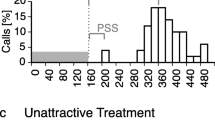Abstract
Males of the quacking frog Crinia georgiana produce calls consisting of 1–11 notes. Playback experiments using synthetic calls showed that males tend to match the number of notes in 2-note and 4-note stimuli; however, males tended to produce more than 1 note in response to a 1-note stimulus and fewer than 8 notes in response to an 8-note stimulus. Successive playbacks of two, 4-note calls from separate speakers indicate that males are likely to match the combined number of notes in the calls of two neighbors, even if they are not equidistant from the focal male. The results are compared with the few other studies of matching in anurans, and interpreted in terms of hypotheses developed to explain matching in songbirds. One attractive and testable hypothesis for call matching in C. georgiana is that males are attempting to produce calls that are at least as attractive to females as those of rivals, without wasting energy.
Similar content being viewed by others
Author information
Authors and Affiliations
Additional information
Received: 14 February 2000 / Received in revised form: 11 April 2000 / Accepted: 3 May 2000
Rights and permissions
About this article
Cite this article
Gerhardt, H., Roberts, J., Bee, M. et al. Call matching in the quacking frog (Crinia georgiana). Behav Ecol Sociobiol 48, 243–251 (2000). https://doi.org/10.1007/s002650000226
Issue Date:
DOI: https://doi.org/10.1007/s002650000226




